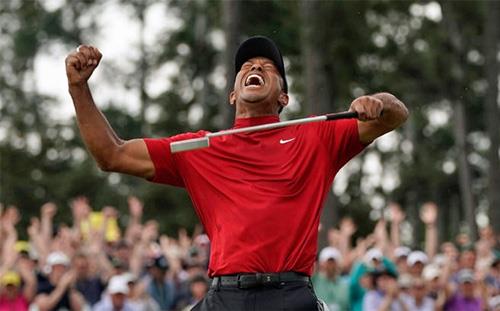
We love an unexpected success story, we're riveted by a downfall-of-the-mighty story, and there's nothing as heartwarming as a good resurrection tale.
Tiger, a two-part HBO documentary on Tiger Woods that starts Sunday at 9 p.m. ET, offers all three.
It doesn't settle the question of whether Tiger Woods is the best golfer ever. It places him on the top level, lets a few experts weigh in, and then leaves it up to the fans and viewers, which is fair.
The documentary itself, whose second part will air a week from Sunday in the same timeslot, spends more time hunting for Woods the person. The findings here are mixed, somewhat less impressive than his skills with a golf club.
The film starts with the declaration from Earl Woods, Tiger's late father, that his son will "transcend the game . . . and make the world a better place."
That's a fair amount to put on someone's shoulders, even someone with a gift, and Tiger strongly suggests that Earl's obsessive drive and expectations planted the seeds both for his son's rise and his son's fall.
Earl pushed Tiger into golf from the time he could walk, a scenario that has produced champions and tragedies inside and outside the sports world. Teenage tennis players and Michael Jackson come to mind, as does Todd Marinovich, whose father engineered him to become a pro football quarterback and left his life in tatters.
If Earl pushed, Tiger did not resist because he rapidly began living up to those expectations and accruing the rewards. He studied the game, he worked at the game, and he became the best player in the world. Not by a little. By a lot. He dominated golf and forced other golfers to make quantum leaps if they were to have any hope of challenging him.
This came at a price. When Tiger had his first serious girlfriend, Earl and his mother hammered him into dropping her because a relationship might take his eye off the prize.
That girlfriend, Dana Parr, is among the interviewees here. She has the breakup letter he sent her. It's calculating and cold.
Some of Woods's friends suggest here that Tiger never had a normal childhood or teenhood, like other child prodigies. He never went through the normal drills, never made the normal mistakes. So after his father died, leaving him untethered, he started doing adolescent things like playing around with many women. Trouble is, he was already married to one.
Tiger's extramarital love life was tabloid gold for months, shattering both his marriage and his previous reputation as one of the good guys in sports, an elite athlete who went home at night to his wife and kids.
The first of those women to have surfaced, Rachel Uchitel, says here that Woods didn't take part in traditional one-night stands with these women. He talked about deep affection and getting close, which had the unfortunate effect of making each think she was "the one."
These personal dramas also affected his golf game, just as Earl feared. Before the revelations, Tiger seemed on an unstoppable path toward the record he most cherished: winning more major tournaments than anyone before him. Jack Nicklaus had won 18. Tiger was up to 14, with years ahead of him.
The love life scandal took him out of the picture for a while, with a trip to rehab. Around the same time, a few physical problems began to surface, the most serious of which ultimately affected his back.
He turned to prescription drugs and was eventually arrested in Florida for trying to drive after taking five of them.
Combined with a back so badly hurt that he needed help getting out of bed, this pretty much completed Woods's fall.
As golf fans know, however, that didn't turn out to be his 18th hole.
He found back rehab that worked, kicked the opioids, and seemed to stay out of trouble while working his way back into his old golf form.
In 2019 he won the Masters, one of the major tournaments. He's still three behind Nicklaus, and he's not the unstoppable force he was a few years ago. But he's a force nonetheless, and his resurrection was as improbable as his fall.
This gives directors Matthew Heineman and Matthew Hamachek a full circle making Tiger feel almost like a scripted story.
Still, it feels like it's missing a few pieces.
It spends relatively little time on race when we're talking about a sport where Tiger won tournaments at clubs that wouldn't admit black members.
It also doesn't really address the impact of Woods and his success on society, that larger picture Earl Woods was talking about. Did Tiger, through his breathtaking and undeniable skill, erase color from the equation, or was he almost a separate figure, a bright shining anomaly?
Tiger does suggest that for much of his career, Woods was a man apart, quick with a smile and words of gratitude, but uncomfortable with celebrity and reluctant to join a fraternity of colleagues that his mother and father had always told him he had to hammer into the ground.
Heineman and Hamachek suggest that since his comeback, he has struck a balance. While he's no less fierce on the golf course, he seems to enjoy himself a little more. He's less of an island.
Woods may not wind up on the god-like peak his father envisioned, partly because his father assumed that great athletic skill rendered other, more mundane life skills irrelevant.
One of the lessons of Tiger is that they aren't.
On the other hand, his flaws don't negate those athletic skills. He is and will remain one of the best ever to play the game.
The most recent news footage of Tiger Woods, shot after this documentary had wrapped, shows him joyfully playing in a father-son tournament with his own pre-teenager.
You hope he's mentioning that sometimes it takes more than a sand wedge to get out of life's traps.